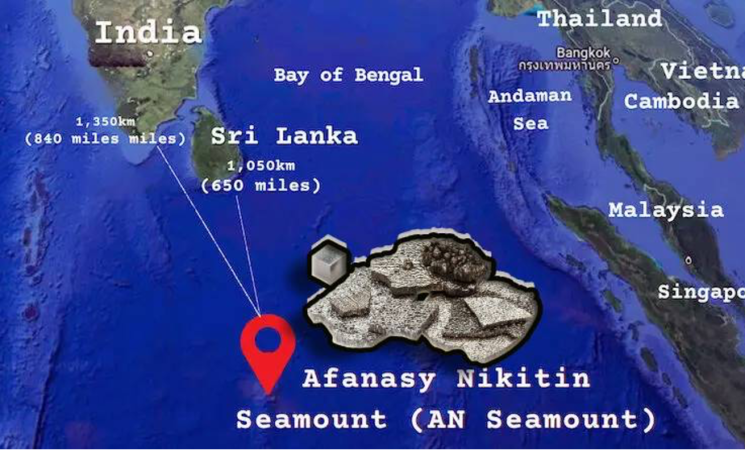22 January 2025, NIICE Commentary 9861
Dr. Punsara Amarasinghe
The currents of the law of the Sea remain volatile depending on the geopolitical trajectories it faces. When Grotius crafted the term, ‘Mare Liberum’ to legitimize the rights of navigation for the Dutch, it certainly equated with the complex trade aspirations of the ‘Dutch East India Company’ to increase their profit. The whole gamut of international law is more or less driven by the realities stemming from the political sphere and this reality stands as a perennial truth. It is in this context, that we should look at ongoing legal entanglement for Afanasy Nikitin Seamount in the Central Indian Ocean as it discloses the blatant geopolitical realities that Sri Lanka cannot vanquish.
‘Afanasy Nikitin Seamount’ is a structural feature located in the Central Indian Ocean nearly 3000 kilometres away from the Indian Subcontinent and is named after a Russian merchant who visited India in the 16th century and a set of Soviet scientists discovered the larger territory of the Seamount in 1958. It is assumed to be an apt ground for a vast array of minerals such as cobalt, nickel, manganese and copper, which are yet to be discovered. For any actual exploration to happen, the interested countries should make an application to the ‘International Seabed Authority’, an autonomous organization established under the ‘United Nations Convention on the Law of the Sea’ (UNCLOS).
The conceptual framework for applying to the ‘International Seabed Authority’ arose from the acumen of the late Shirley Amarasinghe, an old-school genius from the distinguished Ceylon Civil Service who chaired the ‘International Convention on the Law of Sea’ in 1978. When drafting UNCLOS, Amerasinghe recognised that the provisions on the delimitation of the continental shelf in Article 76 of the draft convention could potentially lead to unfair outcomes for Sri Lanka’s continental shelf.
Based on the exclusive rights provided by the International Law of the Sea Convention, India made a formal application to Jamaican based International Seabed Authority (ISA) to seek approval to explore the Afanasy Nikitin Seamount, which is a pretext to uncover the rich Cobalt resources within the Seamount.
The question that arises is whether the Afanasy Nikitin Seamount is located within a territory claimed by Sri Lanka as its continental shelf. Colombo was pleased with (ISA) to refrain from allowing New Delhi to explore the Seamount until Sri Lanka’s request for the continental shelf claim gets approved by the ‘United Nations Commission on the Limits of Continental Shelf’.
Sri Lanka applied for its claim for the Continental Shelf in 2009 under UNCLOS of 1982, for the extension of its continental shelf. In the first instance, New Delhi’s response to its neighbour was a positive one as India’s permanent mission to the UN acknowledged it in May 2010 without an objection, which later changed in 2022. The letter was issued on 22 October 2022 by India’s Permanent Mission to the U.N. states.
“The consideration and qualification by the Commission of the submission made by Sri Lanka would prejudice the rights of India over the parts of the continental shelf, as India has the right to make further submissions under the Statement of Understanding. Therefore, in accordance with paragraph 5(a) of Annex I of the Rules of Procedure of the Commission, the Government of the Republic of India requests the Commission not to "consider and qualify" the submission made by Sri Lanka.”
The current change of perceptions has its footprints in the complex geopolitical tensions looming in the Indian Ocean region. In particular, the gradual presence of Chinese research vessels challenging the traditional Indian-centric security architecture in the region makes a stir in the highest echelons in New Delhi. Perhaps from a vantage point, India’s claim to the Afanasy Nikitin Seamount is rooted in New Delhi’s ambitions to deter any possible Chinese presence in the region. China’s presence in the Indian Ocean has given a tense time to India, mainly the way it influenced small island nations like Sri Lanka and Maldives proves Delhi’s fear that China may exploit the Seamount.
The internal political dynamics within India cannot be ignored as they bolster every foreign policy decision that New Delhi makes. Unlike the Congress Government, which was in power when Sri Lanka applied for the extended Constitutional Shelf in 2009, the present Government headed by the BJP aggrandizes a typical realist position in its foreign policy, in which India’s concerns become prime.
The ‘crème de la crème’ of the whole problem is the value of Cobalt as a rare mineral and Afanasy Nikitin Seamount is assumed to be a breeding ground for Cobalt. According to the International Economics Forum, the demand for Cobalt will be increased by 2030 due to the adoption of electronic vehicles. In this case, Cobalt can generate enormous wealth for its owning parties and countries that intend to explore Cobalt should have the sophistication to complete their exploitations. As a country embittered by the economic crisis and internal political chaos in a decadent system, Sri Lanka lacks the technical-financial capabilities to explore the Afanasy Nikitin Seamount. But, such a lacuna does not open a path to another country to exploit it at one’s cost.
To conclude, the entanglement over Afanasy Nikitin Seamount reveals the tip of the iceberg that encompasses the whole Indian Ocean. It resonates with India’s fear of losing its grip over the Indian Ocean as the Chinese presence grows. India might have gazed at the Seamount to mitigate Chinese infiltration, but it clearly contains economic aspirations, too.
Dr. Punsara Amarasinghe is a Post-Doctoral Researcher at Scuola Superiore Sant Anna, Pisa.

